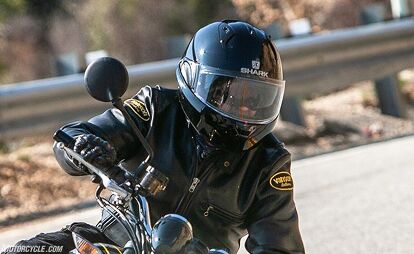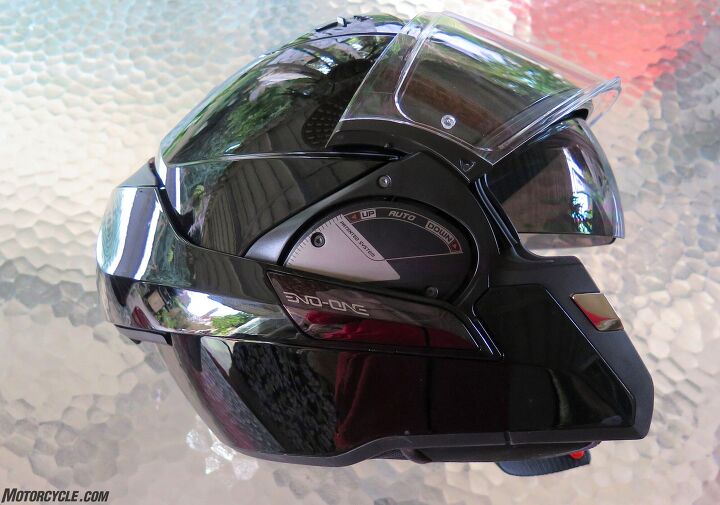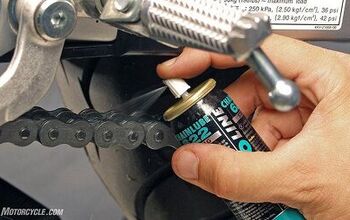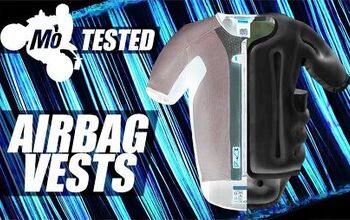MO Tested: Shark Evo-One 2 Modular Helmet Review
An elegant solution to a mostly non-existent problem
We’ve now sung the praises of the modular helmet enough that all regular readers probably have the chorus down: It’s excellent to be able to flip up the whole front of your helmet when you want to talk to people or quaff a refreshing drink while you’re stopped for gas, etc., without having to take the whole thing off your head.
Shark EVO-One 2 modular helmet
| Aesthetics | 8.0/10 |
| Protection | 9.0/10 |
| Value | 8.0/10 |
| Comfort/Fit | 9.0/10 |
| Quality/Design | 8.5/10 |
| Weight | 7.5/10 |
| Options/Selection | 8.0/10 |
| Innovation | 9.50/10 |
| Weather Suitability | 8.5/10 |
| Desirable/Cool Factor | 9.0/10 |
| Overall Score | 85/100 |
Then back up to speed, flip it back down and enjoy full-face protection. I mean, that’s what I always do. I’ll leave it open when rolling around at sub-30 mph speeds, but once above that I always button my modular back up to ward off rocks and bees and slings and arrows. Some people, though, like to ride open-faced at speeds that will turn the cocked-open part of the helmet into a sail, possibly while in the cockpit of a full-fairinged touring bike, or, I really don’t know?
For them (whoever they are), Shark has solved the problem (again) with this latest modular design, introduced two years ago. The chinbar on this one rotates all the way over the face shield and round to the back, where it clicks securely into place. As they say in France, where Sharks are designed, Viola! Actually, they say Voilà.
Being French, maybe it’s a fashion thing, too? Maybe it does look a little dorky when you’re walking around or lane-splitting the Champs-Élysées with that big helmet chunk propped atop your head when you’re wearing a normal modular? No worse than a beret. But if you just enjoy gadgetry for its own sake, the Evo-One 2 is pretty slick.
Cool mechanism aside, the Shark is a perfectly nice modular. A series of Arais has led me to the fact that my head is an intermediate oval. Shark says the Evo-One 2 is more of a round oval shape, but its size L fits my head just as comfortably as all my favorites, if not quite as form-fittingly as my favorite Shoei Neotec 2. From the outsides, it appears to be a bit wider than the Shoei – especially the jowly chinbar – which is way better than being too narrow. The extra width makes it at least easy to wear stylish eyewear – but you definitely need to try the Evo on before buying if your head is a long oval or otherwise misshapen.
Along with the width and mechanical goings-on, you might expect more wind noise, but the faceshield seals well all the way round, and I didn’t feel like the Shark was any louder, or more breezy inside, than most quality helmets. There’s a chin curtain that lives flat against the inside of the chin bar, that you can pull down with one finger; it really does reduce both noise and airflow when it’s in place. To be honest, I haven’t really checked the helmet’s ventilation capacity; it’s been pretty chilly every time I’ve worn it. There’s a smallish vent at the center base of the faceshield, and two more closeable vents on top that channel to a central rear vent that remains open.
The removable CoolMax liner is easier to remove and replace, in one piece, than most, and the cheekpads pop out easily: They’re available in different thicknesses. While it’s not as plush as the interior of a Shoei or Arai, the Shark seems close enough for the reduced cost. We’ve got speaker indentations in the liner that appear to be in the right spots for my ears, but they’re pretty small, not very deep, and may require modifications for bigger or thicker speakers. Shark makes its own “Sharktooth” Bluetooth system, but it’s, strangely, not compatible with the Evo-One 2.
We’re looking at $430 for a solid-colored Evo-One 2 like my black one here, and up to $470 for graphics. For a thermoplastic helmet, that’s a little on the pricey side, but still a lot less than a Neotec or Schuberth – and the Shark Evo-One 2 is a unique helmet and French besides. I’ve worn mine on a few long days now and emerged at the end with zero hotspots or headaches. My postal scale has it at exactly 4 pounds, 0.1 ounce, which is slightly heavier than light. Again, if your head is round-oval, this could be your dream lid. And if you like to ride at speed with full facial nudity, it’s the only game in town. Furthermore, the Evo-One 2is DOT approved for riding with the chin-bar in both open and closed positions, which isn’t the case with all modulars.
Shark has never been huge in North America, but they’ve been building great helmets for a long time and are looking to expand.
We are committed to finding, researching, and recommending the best products. We earn commissions from purchases you make using the retail links in our product reviews. Learn more about how this works.
More by John Burns










































Comments
Join the conversation
I once had an earlier version of the Shark Evo (Australia) but bits dropped off it, wasn't impressed and made a successful warranty claim. As an aside, wouldn't wind noise be good to include in the ratings items?
Thanks for your article, John. However, I think it IS an existent problem. But I guess, the arid North American climate doesn't warrant open face neccessity as the tropics would. Slow heavy traffic city speeds also don't require chin guard, and Campi the Bat highlighted a relevant point.
Apart form that, an added advantage during touring would be when I roll into small towns, and explore the small town, full face helmets are a bit more imtimidating to the locals there. Switch to open face (homologated) position, and people are more friendly when they can see the rider's facial expression. So it's a great 2-in-1 touring lid.
On the point of Mark's comment regarding the former Evo series: The Shark Evo (Evoline) is so very different from the Evo-One and the revised Evo-One 2. I had the Evoline 3 Carbon and an Evo-One and Evo-One 2. Between the older Evoline series to the current Evo-One 2, they are world's apart. Size-wise, I like how a British reviewer put it - he compared the size difference between the two to a grapefruit and an orange! The features, quality and design changes are a lot different (improved - except the lack of carbon fibre - no carbon fibre options).
Anyway, The EVO-ONE 2 is an extremely comfortable and versatile helmet expecially in the tropics. I feel the ventilation on the move over the scalp (I ride a naked bike), and can lift the cinguard when I'm on precarious off road explorations and need to get a better view of the ground.
The only real con for me is the weight, especially after adding on a comms set Sena 10C (Camera) - but that's an optional choice - I had an UClear AmpGo on it before the Sena and it was of course, a tad lighter.